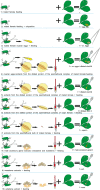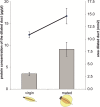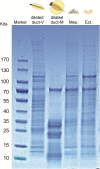Mating Status of an Herbivorous Stink Bug Female Affects the Emission of Oviposition-Induced Plant Volatiles Exploited by an Egg Parasitoid
- PMID: 31031636
- PMCID: PMC6473057
- DOI: 10.3389/fphys.2019.00398
Mating Status of an Herbivorous Stink Bug Female Affects the Emission of Oviposition-Induced Plant Volatiles Exploited by an Egg Parasitoid
Abstract
Insect parasitoids are under selection pressure to optimize their host location strategy in order to maximize fitness. In parasitoid species that develop on host eggs, one of these strategies consists in the exploitation of oviposition-induced plant volatiles (OIPVs), specific blends of volatile organic compounds released by plants in response to egg deposition by herbivorous insects. Plants can recognize insect oviposition via elicitors that trigger OIPVs, but very few elicitors have been characterized so far. In particular, the source and the nature of the elicitor responsible of egg parasitoid recruitment in the case of plants induced with oviposition by stink bugs are still unknown. In this paper, we conducted behavioral and molecular investigations to localize the source of the elicitor that attracts egg parasitoids and elucidate the role of host mating in elicitation of plant responses. We used as organism study model a tritrophic system consisting of the egg parasitoid Trissolcus basalis, the stink bug host Nezara viridula and the plant Vicia faba. We found that egg parasitoid attraction to plant volatiles is triggered by extracts coming from the dilated portion of the stink bug spermathecal complex. However, attraction only occurs if extracts are obtained from mated females but not from virgin ones. Egg parasitoid attraction was not observed when extracts coming from the accessory glands (mesadene and ectadene) of male hosts were applied, either alone or in combination to plants. SDS-PAGE electrophoresis correlated with olfactometer observations as the protein profile of the dilated portion of the spermathecal complex was affected by the stink bug mating status suggesting post-copulatory physiological changes in this reproductive structure. This study contributed to better understanding the host location process by egg parasitoids and laid the basis for the chemical characterization of the elicitor responsible for OIPV emission.
Keywords: Nezara viridula; OIPVs; Trissolcus basalis; Vicia faba; elicitor; indirect plant defenses.
Figures




Similar articles
-
Egg parasitoid attraction toward induced plant volatiles is disrupted by a non-host herbivore attacking above or belowground plant organs.Front Plant Sci. 2014 Nov 5;5:601. doi: 10.3389/fpls.2014.00601. eCollection 2014. Front Plant Sci. 2014. PMID: 25414714 Free PMC article.
-
Identification of volatile synomones, induced by Nezara viridula feeding and oviposition on bean spp., that attract the egg parasitoid Trissolcus basalis.J Chem Ecol. 2004 May;30(5):945-64. doi: 10.1023/b:joec.0000028460.70584.d1. J Chem Ecol. 2004. PMID: 15274441
-
What's my age again? Assessing the impact of stink bug egg mass age on host recognition by egg parasitoids Trissolcus basalis and Trissolcus japonicus (Hymenoptera: Scelionidae).Front Physiol. 2025 Jul 17;16:1588946. doi: 10.3389/fphys.2025.1588946. eCollection 2025. Front Physiol. 2025. PMID: 40746985 Free PMC article.
-
Chemical, Physiological and Molecular Responses of Host Plants to Lepidopteran Egg-Laying.Front Plant Sci. 2020 Jan 30;10:1768. doi: 10.3389/fpls.2019.01768. eCollection 2019. Front Plant Sci. 2020. PMID: 32082339 Free PMC article. Review.
-
Plant responses to insect egg deposition.Annu Rev Entomol. 2015 Jan 7;60:493-515. doi: 10.1146/annurev-ento-010814-020620. Epub 2014 Oct 20. Annu Rev Entomol. 2015. PMID: 25341089 Review.
Cited by
-
Evaluation of the Parasitism Capacity of a Thelytoky Egg Parasitoid on a Serious Rice Pest, Nilaparvata lugens (Stål).Animals (Basel). 2022 Dec 20;13(1):12. doi: 10.3390/ani13010012. Animals (Basel). 2022. PMID: 36611621 Free PMC article.
-
Electrophysiological Responses of Trissolcus japonicus, T. basalis, and T. oenone (Hymenoptera: Scelionidae) to Volatile Compounds Associated with New Zealand Stink Bugs (Hemiptera: Pentatomidae).J Chem Ecol. 2024 Dec;50(12):1056-1066. doi: 10.1007/s10886-024-01533-7. Epub 2024 Aug 3. J Chem Ecol. 2024. PMID: 39095554 Free PMC article.
-
Integrating Chemical Ecology with Behavioural Bioassays to Understand Host Preferences in the Stink Bug Egg Parasitoids Trissolcus basalis and Trissolcus oenone (Hymenoptera: Scelionidae).J Chem Ecol. 2025 May 28;51(3):60. doi: 10.1007/s10886-025-01616-z. J Chem Ecol. 2025. PMID: 40425981 Free PMC article.
-
Egg parasitoid exploitation of plant volatiles induced by single or concurrent attack of a zoophytophagous predator and an invasive phytophagous pest.Sci Rep. 2019 Dec 12;9(1):18956. doi: 10.1038/s41598-019-55396-0. Sci Rep. 2019. PMID: 31831800 Free PMC article.
-
Host feces, olfactory beacon guiding aggregation of intestinal parasites Gasterophilus pecorum (Diptera: Gasterophilidae).Parasitol Res. 2022 Sep;121(9):2601-2613. doi: 10.1007/s00436-022-07577-6. Epub 2022 Jul 5. Parasitol Res. 2022. PMID: 35788769
References
-
- Colazza S., Aquila G., De Pasquale C., Peri E., Millar J. G. (2007). The egg parasitoid Trissolcus basalis uses n-nonadecane, a cuticular hydrocarbon from its stink bug host Nezara viridula, to discriminate between female and male hosts. J. Chemi. Ecol. 33 1405–1420. 10.1007/s10886-007-9300-7 - DOI - PubMed
LinkOut - more resources
Full Text Sources

